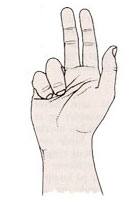Definition and causes of Dupuytren’s contracture

Dupuytren's contracture causes
a thickening and shrinking of
the tissues in the palm and causes
the little finger and ring finger
to bent inward toward the palm
Dupuytren’s contracture is a progressive shortening of the large tendon sheath in the palm of the hand leading to impaired function of the fingers. The disorder is not uncommon and usually affects men.
The palm tendon sheath, which lies in a layer between the skin and the tendons bending the fingers, thicken and slowly erode. The result is that the fingers passively bent against the palm of the hand and with time can no longer be stretched. Finally the fingers become practically useless.
Most often Dupuytren’s contracture affects the ring finger and the little finger, and can affect both hands or just one hand. The first sign is usually the formation of small nodules in the palm of the hand, and with a gradual build up of strands of connective tissue to the underside of the fingers.
The reason for Dupuytren’s contracture is unknown, but hereditary factors are believed to play a role.
Precautions and diagnosis
If you find that your fingers and especially the ring finger or the little finger gradually bend towards the palm of the hand with problems stretching them you should consult your doctor.
The doctor can assess the condition or refer to the hospital where you can get a detailed diagnosis.
Treatment of Dupuytren’s contracture
The only real treatment for the condition is surgery, which removes the connective tissue strands preventing the fingers to stretch. This is usually done by making small z-shaped cuts, both to the front of the fingers and the palm of the hand - this is obviously performed under anesthetic.
The operation is relatively common, and often with a good result. Experience has shown that it is preferable to wait with surgery until the fingers can no longer be stretched. After the operation the fingers are reactivated with rehabilitation and exercises.
Outlook and complications
As with all operations there is a small risk of post surgery infection but the risk is very small in this type of surgery. After the operation the doctor will inform what to be aware of.
After the operation, it is important to undertake good rehabilitation of the fingers and patients are usually referred to a therapist, who instructs in various exercises. The therapist may design and make a splint to be worn at night at the beginning of the process. The splint insures that you cannot bend the fingers and thereby reduces the likelihood that the tendons contract again.
The post surgery situation usually has a positive outlook, but for some patients the contracture will recur. It is also very individually when patients can return to work.
Læs denne artikel på dansk |